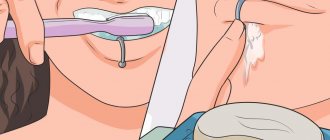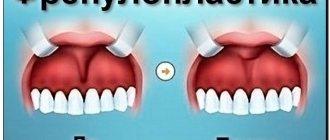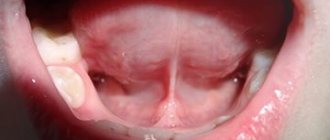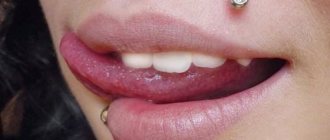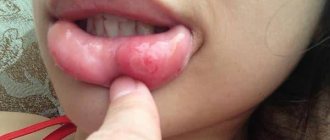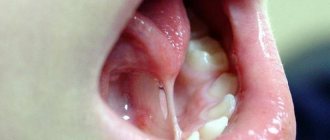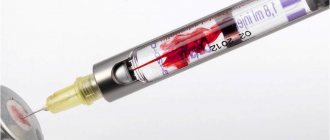May 31, 2020
Under the upper lip, right in the center of each person, there is a ligament that connects the lip to the alveolar part of the jaw and is called the frenulum. For some, this ligament is short and attached too low, which creates certain difficulties and health problems, which we will definitely talk about below. In this regard, doctors suggest that such patients undergo plastic surgery of the upper frenulum. And UltraSmile.ru journalists will tell you about the operation and its indications in detail.
There are many indications for frenuloplasty
Few people know that the upper frenulum is very important for the correct and full functionality of the dental system. Thanks also to her, we can move our lips, pronounce different sounds, and open our mouths. It also plays an important role in the formation of a beautiful smile aesthetics. If it is shortened or positioned incorrectly, then in some cases this creates conditions for the development of various anomalies and leads to serious problems and consequences, which, in fact, are indications for trimming the frenulum of the upper lip in adults and children.
At what age is it best to have surgery?
Trimming the frenulum of the upper lip is a relatively easy operation, but the optimal age for it, according to most doctors, is 5–7 years, when the permanent incisors begin to emerge. If you carry out the procedure during this period, you can avoid the formation of a diastema and further manipulations to correct the bite by the orthodontist. But according to indications, it is not too late to perform plastic surgery in adolescence, and even in adults.
“I took my child to this operation. My son was 8 years old at the time. He already understood everything that was said to him, and at the same time he was very afraid. Before the operation, we sat and calmed down in the doctor’s office for about 15 minutes. I want to say that the child’s psychological attitude is very important here. About the operation itself: it didn’t hurt, my son didn’t cry. But after the anesthesia began to wear off, he complained that his gums hurt, but this problem was solved with Nurofen syrup. Already on days 4–5, the trace of the wound was almost invisible, although it was done with a scalpel. But in children everything heals quickly.”
Lada, review from the dental portal gidpozubam.ru
The operation is best performed at the age of 5-7 years
What is dangerous about the pathology of the frenulum attachment?
Indications for frenuloplasty arise not because of doctors’ desire to correct an anatomical feature, but for compelling reasons that affect the health and beauty of the smile. A similar defect results in:
- to the formation of a diastema - an excess gap (gap) between the front incisors, which, moreover, tends to expand. A short frenulum is fixed too close to the edge of the alveolar process and pushes the teeth in different directions;
- the appearance of a gum pocket - a depression behind the gum due to its injury by the frenulum, where food debris begins to accumulate, tartar forms, and the exposed necks of the teeth suffer from increased sensitivity. Ultimately, this process can lead to periodontitis, loosening and loss of teeth;
- speech problems - with a short frenulum it is difficult to pronounce many consonants and some vowels (“o”, “u”);
- bite pathologies - due to improper closure, tooth enamel is erased, teeth grow in the wrong direction, oral hygiene, the quality of chewing food and the functioning of the entire gastrointestinal tract deteriorate, and at the same time, a short frenulum prevents the correct installation of the braces system;
- difficulties when performing prosthetics - a short frenulum does not allow the prosthesis to be firmly held in the mouth, and it may fall out while eating or talking;
- injury during individual oral hygiene and its deterioration in general.
Types and technologies of upper frenuloplasty
Before the procedure, it is important to carry out a complete sanitation of the oral cavity, treat diseased teeth and stop acute inflammatory processes, remove bacterial plaque - all these are sources of infection, which can subsequently provoke postoperative complications. You should also eat before surgery, as hunger can impair blood clotting.
There are several techniques for performing the procedure. The doctor decides which one to use depending on the patient’s age, the location and attachment of the frenulum. Let's list all the technologies that exist today:
- frenotomy, or frenulotomy: involves transverse dissection of the frenulum if it is very narrow and thin. This is the so-called minor operation, which is considered the least traumatic. The purpose of the manipulation is to relieve the tension of the ligament. The procedure can be performed on newborns, as well as older children,
- frenectotomy: this is a more complex operation, during which the frenulum of the upper lip is trimmed and part of the tissue located in the space between the central incisors is removed. The procedure is performed if the frenulum is thick, as is often the case in adolescent and adult patients,
- frenuloplasty: the doctor releases the ligament and moves it to the area where it should be.
The operation is performed under local anesthesia.
Each of the listed operations is performed on an outpatient basis, under local anesthesia. Traditionally - using a scalpel. Afterwards, the doctor applies self-absorbing sutures and sends the patient home. Everything lasts about 10–15 minutes. Next, the patient receives clear recommendations on how to behave during the rehabilitation period. 1 and 3 days after the operation, you need to visit the doctor again for follow-up examinations.
Today, plastic surgery of the upper frenulum can be performed using a laser, which allows the procedure to be carried out quickly, without pain and blood, and to disinfect the operated tissues. This also reduces the likelihood of developing postoperative complications (swelling, pain, inflammation, scars). A big advantage is that when using laser equipment there is no need to apply stitches.
Laser frenulum trimming is the least traumatic
The rehabilitation period takes about 10–14 days. During this time, the patient is not recommended to eat food that can irritate the operated tissues (cold, spicy, hot, hard). It is also necessary to rinse your mouth with an antiseptic and apply wound-healing ointments (for example, Solcoseryl).
Notice
: Undefined variable: post_id in
/home/c/ch75405/public_html/wp-content/themes/UltraSmile/single-item.php
on line
45 Notice
: Undefined variable: full in
/home/c/ch75405/public_html/wp-content /themes/UltraSmile/single-item.php
on line
46
Rate this article:
( 3 ratings, average: 5.00 out of 5)
prevention
- Alimirzoev F.A. Dental anomalies in childhood and their diagnosis // Achievements of university science. – 2014.
How long will it take to heal?
After plastic surgery of the frenulum of the lower lip, the rehabilitation period takes up to two weeks, and the wound on the upper lip heals in just a few days. In the first case, anti-inflammatory treatment is often prescribed to ease the postoperative period and eliminate the risks of complications.
To avoid injury and the risk of infection, thorough but gentle oral hygiene twice a day is necessary. You should avoid hard and hot foods in your diet, and rinse your mouth after eating. Parents are advised to pay closer attention to the cleanliness of their child’s hands.
Return to list of articles
Comments
Which doctor can give a referral for this operation?
Marina (06/14/2020 at 07:28 pm) Reply to comment
- You can get a referral after an examination by a dentist or periodontist, orthodontist, speech therapist, or neonatologist (for newborns). The operation itself is performed by a dental surgeon.
Editorial staff of the portal UltraSmile.ru (06/17/2020 at 09:07) Reply to comment
Write your comment Cancel reply
Upper lip frenuloplasty
Plastic surgery of the frenulum of the upper lip is a surgical intervention to trim the frenulum, performed on the patient if there are appropriate indications in the direction of an orthodontist or speech therapist. The frenulum of the lip is a special fold of the oral mucosa, which is responsible for additional attachment of the upper lip to the jaw bones.
In its normal position, the frenulum is woven into the gum at approximately a distance of 0.5-0.8 cm from the necks of the anterior incisors. With a lower attachment or when the frenulum of the lip extends beyond the front incisors and the attachment point is not visible at all, it is considered short. In such cases, it begins in the middle part of the upper lip and is attached approximately 0.4-0.6 cm above the gum, in the area of the gap between the front incisors (diastema).
A short frenulum is easily detected by visual inspection. To do this, you just need to retract the upper lip and examine the place where the mucous cord is woven.
When the frenulum is in a normal position, it does not have a negative effect on health and does not interfere with speech. A shortened frenulum can cause the development of a number of disorders. To correct it, an operation to plasticize the frenulum of the upper lip is performed.
Need for surgery
Most parents have a rather vague idea of the functions of the frenulum of the upper lip and its role in the normal functioning of the dental system. Therefore, when a specialist talks about the need for plastic surgery, many do not understand the importance of it. In reality, the problem must be resolved in a timely manner to avoid unpleasant medical and aesthetic consequences. It is the presence of the frenulum that allows you to correctly articulate, move your lips, open and close your mouth. With its defects (too short frenulum, its improper fastening), the mobility of the lips is significantly reduced, their functioning is disrupted, and various aesthetic defects develop.
The presence of such an anomaly leads to a number of consequences:
- Limited sucking function in newborns. Since in infants the upper lip, together with the tongue, takes an active part in sucking, impaired mobility becomes an obstacle to the process of breastfeeding. In some cases, a neonatologist can independently trim the frenulum of the upper lip.
- Impaired speech formation and correct sound pronunciation. With a shortened frenulum of the upper lip, as a rule, difficulties arise when pronouncing labial sounds, vowels (“o”, “u”, etc.). In this case, the speech therapist recommends plastic surgery, after which the diction is automatically corrected.
- At an older age, due to frenulum defects, bite and chewing functions may be impaired, resulting in digestive problems.
- The shortened frenulum of the lip, as well as its close attachment to the edge of the alveolar process, causes retraction of the interdental papillae of the gums in the space between the incisors. As a result, a gap is formed in the bone tissue between the sockets of the teeth - a diastema. In addition, the distance between the crowns increases.
- A short frenulum pulls back the gums and leads to the formation of a gum pocket, the deposition of tartar and the development of an inflammatory process in the gums.
- The consequences of defects in the frenulum of the upper lip can be instability of the teeth, exposure of their roots, and increased sensitivity. Plastic surgery allows you to avoid the development of a number of dental diseases.
- A frenulum that is too wide leads to regular accumulation of food debris and the formation of plaque.
- Surgery to correct the frenulum of the upper lip is necessary for the prevention of periodontal diseases and inflammatory processes in the oral cavity.
Indications
Medical intervention of any type must certainly be justified. A simple statement of the fact of the presence of a shortened frenulum is not an indication for emergency surgery. Plastic surgery to correct the frenulum is performed in the following cases:
- If there is a diastema (gap) between the central incisors. The frenulum of the upper lip, woven into the interdental papilla and forming a thick cord, prevents the incisors from converging towards the center. In addition, exposure to a small constant load leads to a gradual increase in the diastema and displacement of the teeth forward and to the sides from the center, as well as the development of periodontitis due to constant injury to the interdental papilla.
- In preparation for orthodontic therapy. Soft tissue cords located in the oral cavity, including the frenulum of the upper lip, exert a certain load on the dentition and influence the formation of the bite. If bite correction procedures are prescribed (installation of plates or braces), you also need to pay attention to the correct attachment of the upper lip frenulum.
- If you have periodontal diseases and are at increased risk of their occurrence. In these cases, the short frenulum seems to “pull” the mucous membrane from the base of the teeth, which leads to gum recession - raising its edge and exposing the roots of the teeth.
- In preparation for removable prosthetics. If the installation of dentures is planned, then it is first necessary to perform plastic surgery of the frenulum of the upper lip, since a shortened frenulum will provoke the shedding of the dentures.
- In case of impaired sound production and other speech therapy problems (as a rule, this indication is less common than others).
Optimal time for the procedure
Although plastic surgery of the upper lip frenulum is a minor operation and does not lead to any consequences, it is performed extremely rarely on infants - only when there is a significant disruption of the breastfeeding process
The optimal age is over 5 years. This is a period of active change of bite, loss of milk teeth and eruption of permanent teeth, when the central teeth have erupted by at least 1/3, and the lateral ones have not yet appeared. Carrying out plastic surgery at this stage will help avoid the formation of a gap and will help the central incisors move towards the center (the erupting lateral incisors will also help with this).
Some experts recommend correction of the upper lip frenulum at 7-8 years of age, when the four upper incisors have already fully erupted. If indicated, the operation is also performed in adolescence and older age.
Contraindications
Surgery to correct the frenulum is not performed in the presence of the following conditions and diseases:
- recurrent diseases of the oral mucosa;
- Smile before and after frenuloplasty
- osteomyelitis;
- multiple caries with complications;
- radiation irradiation of the head and neck area.
Of the general contraindications, it should be noted:
- cerebral lesions;
- dysmorphophobia;
- alcohol abuse;
- mental illness;
- blood diseases (leukemia, hemophilia);
- infectious diseases in the acute stage;
- chronic diseases;
- oncological diseases;
- collagenosis, tendency to form keloid scars.
Preparing for surgery
No special preparation is required for the procedure. The oral cavity should be sanitized, since the presence of a source of infection can lead to the development of complications. Some specialists prescribe tests and fluorography, but there is no particular need for them: plastic surgery of the frenulum of the upper lip is a low-traumatic operation.
The only recommendation is to pre-feed the child, since in a hungry state it is more difficult for him to tolerate the procedure. In addition, hunger can affect blood clotting.
Types of operations and their essence
One of the main conditions for a successful operation: the baby must sit in a chair in a calm state for at least 15 minutes. Plastic surgery is performed using various methods. The choice of a specific method depends on the structure and attachment of the frenulum of the upper lip.
- Frenotomy, or dissection of the frenulum. Its implementation is indicated in cases where the frenulum of the upper lip is too narrow, has the appearance of a transparent film and does not have points of attachment to the edge of the alveolar process. The dissection is carried out in the transverse direction, and suturing is carried out in the longitudinal direction.
- Frenectomy, or excision of the frenulum. Prescribed for wide frenulum of the upper lip. The incision is made along the crest of the tense frenulum, and the interdental papilla and tissues located in the bone space between the root parts of the spread central incisors are excised.
- Frenuloplasty – its essence is to move the attachment site of the frenulum of the upper lip. Currently, two types of frenuloplasty are performed.
Y-shaped frenuloplasty
After local anesthesia, the fixed frenulum is excised with a scalpel or special gum scissors. As a result of excision, a diamond-shaped defect remains on the mucosa. In order to mobilize the edge of the mucosa adjacent to the incision, it is trimmed and, using a thin rasp, moved along the periosteum in the apical direction (deep into the formed vestibule). Inside the vestibule, the mobilized mucous membrane is fixed with an interrupted suture to the periosteum. The wound is sutured tightly.
Z-shaped frenuloplasty (according to Limberg)
Infiltration anesthesia is performed, after which a vertical incision is made in the middle of the frenulum. Two oblique cuts are made in opposite directions from it at an angle of 60 to 85 degrees. The formed triangular flaps are mobilized and then fixed so that the central incision is located horizontally. It is very important to properly prepare the receiving bed: if the edges of the incisions are simply sutured together within the mucosa, you can only achieve a weakening of the tension, but it will not be possible to completely eliminate it. Ignoring this point leads to a significant decrease in the effectiveness of the procedure and, as a consequence, the not very popular popularity of this technique. The receiving bed is prepared in the same way as for Y-shaped frenuloplasty of the frenulum of the upper lip. The submucosal tissues are peeled off along the periosteum using a rasp, after which interrupted catgut sutures are applied to close the horizontal incision, while the flaps are fixed to the periosteum.
All of the above operations for plastic surgery of the upper lip frenulum are performed on an outpatient basis, under local infiltration anesthesia. For pain relief, Ultracan D-S forte containing epinephrine (1:100000 in 1.7 ml) is used.
Absorbable suture material is used to close the wounds, so they do not need to be removed later. The entire procedure takes approximately 15 minutes. According to reviews, it is completely painless and does not even cause discomfort.
Laser plastic surgery
Lately, plastic surgery of the upper lip frenulum using a laser has become very popular. The whole procedure takes only a few minutes.
Local anesthesia is first performed using a special gel, after which the light guide of a laser device is directed to the frenulum, forming a focused beam of light. Under its action, the frenulum “dissolves”. The laser also sterilizes and seals the edges of wounds.
Advantages of the method:
- absence of vibrations and unnecessary sounds that frighten children;
- bloodlessness;
- no need for stitches;
- eliminating the possibility of infection from surgical instruments by sealing the edges of wounds with a laser;
- reducing the time of surgery for plastic surgery of the upper lip frenulum;
- absence of pain and postoperative scars;
- short rehabilitation period.
Postoperative care
As a rule, the period after plastic surgery of the upper lip frenulum is quite calm. Minor pain may occur after the anesthetic wears off. Rules to follow at this time:
- Perform thorough oral hygiene daily.
- Avoid hot and solid foods for 2 days.
- Go through a post-operative examination (on the second or third day).
For older patients, special myogymnastics is recommended - exercises to strengthen facial and chewing muscles.
Over a certain period of time after frenuloplasty, one becomes accustomed to the freer movements of the tongue. Diction changes almost immediately after the correction. To eliminate the gap between the teeth (if it has already formed) it takes a little longer, and in some cases additional dental treatment is necessary.
The rehabilitation period lasts no more than 4-5 days. During this time, all unpleasant sensations disappear, and the wounds are completely healed.
When to see a doctor?
Most people can treat a frenulum tear at home. However, in some situations a doctor may be required.
A person should see a doctor within 24 hours if the injury appears infected but there is no fever.
You should consult a doctor immediately if the following symptoms appear:
- a deep tear that may require stitches;
- severe pain that lasts for several hours;
- difficulty swallowing liquids, including saliva;
- problems with fully opening or closing the mouth;
- increased pain or swelling after 48 hours;
- heat.
If you find an error, please select a piece of text and press Ctrl+Enter.
How to check a child's frenulum?
A shortened frenulum between the lip and gum is diagnosed quite simply even in infants. To do this, you need to carefully pull back the child’s lips and see how pronounced the fold of the mucous membrane is and where it is attached. If it is short, then it will have a thick appearance and its attachment point will be at the very base of the incisors.
The hyoid frenulum normally has a length of at least 8 mm and is attached approximately halfway between the root and tip of the tongue. A small frenulum usually looks like a fold on the mucous membrane, attached along its entire length to the tongue or sublingual space.
Reviews
“We had plastic surgery on our daughter’s short frenulum of her upper lip when she was 6 years old. The procedure was recommended to us by a dentist at the Smile clinic. The whole process took literally a few minutes, they calmed my daughter down, gave her an injection in her gum, so there were no tears. Everything healed within 10 days, there were no problems or complications. Thanks to all the medical staff of the clinic for their professionalism and kind attitude towards children!” Maria, 30 years old
“Before correcting the bite, the dentist recommended cutting the frenulum, due to which there was a gap between my front teeth. Everything went quickly and painlessly. Now I recommend your clinic to my friends.” Olga, 27 years old
“My son had problems with diction due to a short frenulum of the lip. I was very worried about how he would cope with the operation, but the specialists at the Smile clinic quickly found an approach to him and did everything very well. Thank you!" Marina, 33 years old
A short frenulum of the upper lip is a condition that requires proper correction. Lip frenuloplasty is performed without pain and in just one visit to the dentist. The recovery period proceeds easily and without significant restrictions. At the Smile clinic we find an individual approach to patients of any age and in treatment we are guided only by proven, modern methods.
Post-operative care
The rehabilitation period takes one to two weeks. To avoid complications, you must follow your doctor's recommendations:
- monitor the hygiene of the oral mucosa and perform procedures prescribed by a specialist;
- exclude hot, sour and solid foods;
- undergo a follow-up examination with the surgeon who performed the operation;
- do gymnastics to strengthen the chewing muscles.
The above rules will help you return to your normal lifestyle in a short time and prevent deterioration in your health after lip frenuloplasty.
When should the procedure be performed?
The optimal age for surgery is 5-6 years. Children under 4 years of age are not subject to correction. The beginning of cutting off the mucous membrane should be done when the temporary front teeth have already completely fallen out, and the permanent incisors are at the stage of eruption.
What complications can be visualized during the procedure before the age of five: the formation of the jaw after the procedure, as a result of which repeated intervention may be necessary in the future; the child's upper lip performs only a third of the prescribed functions (the child does not speak, does not bite solid food, etc.).
Contraindications
Tongue frenuloplasty in newborns does not involve major surgical intervention, so the operation is considered safe. In addition, the procedure is painless and does not require anesthesia. However, given that after cutting a short fold of mucosa, a small wound still forms, there are temporary restrictions on manipulation related to the child’s health condition.
Temporary contraindications:
- inflammatory diseases;
- infectious diseases;
- immunodeficiency pathologies;
- acute respiratory viral or bacterial infections.
If there are contraindications for health reasons, it is advisable to postpone the operation until complete recovery.
Is special training required?
The procedure does not require special preparation. Immediately before surgery, it is necessary to perform thorough oral hygiene. You also need to feed the child - hunger negatively affects blood clotting. In addition, it will be difficult to eat for several hours after the operation.
Since plastic surgery of the upper lip frenulum is performed mainly on young children, first of all, psychological preparation is necessary. Parents should reassure the child, assure him that the procedure is painless, this will help significantly speed up and simplify the doctor’s work.
Frenules in the oral cavity
When parents talk about the frenulum in the child’s mouth, most often they mean the frenulum of the baby’s tongue, which is quite natural. Problems arise more often precisely because of this oral frenulum: from improper attachment to the breast in the first days of life to speech impairment in the future.
Even dentists give the leading role and importance to this particular frenulum, but this does not mean that the remaining frenulums are unimportant and cannot provoke any pathology.
There are three frenulums in the child's mouth. A frenulum in the oral cavity is nothing more than a small strand of mucous membrane. But, despite this, the frenulum in the oral cavity is of great importance in the life of a child; the child’s nutrition, correct pronunciation of sounds, the condition of the mucous membranes, not to mention the child’s bite and facial aesthetics depend on their condition.
Dentists distinguish between the frenulum of the upper and lower lips and the frenulum of the tongue. Each of them has its own location and performs a number of functions. The frenulum of the lower lip connects the body of the lower jaw and the lower lip; normally, the frenulum is woven into the gum of the lower jaw below the level of the central incisors.
The frenulum of the upper jaw is located according to the same principle as the frenulum on the lower lip. This mucous cord also raises many questions and complaints from parents, since it is primarily associated with the formation of an aesthetic defect in the oral cavity - a gap between the teeth. And the last frenulum in the baby’s mouth is the lingual frenulum, which is woven into the tongue and sublingual space.
Who prescribes the procedure?
If you notice a short pathology, contact the following specialists: neonatologist, orthodontist, speech therapist, periodontist. The dentist or surgeon does not provide objective guidelines for surgery.
- The neonatologist has the right to prescribe intervention if the defect interferes with normal breastfeeding. As a rule, we are talking about pathology of the structure of the upper lip, since it is actively involved in the sucking procedure. In some cases, this specialist may independently perform the removal of the bridge or write a referral to a pediatric surgeon.
- The speech therapist determines the anomaly when speech dysfunction and hypoplasia of the speech organs are visualized. Often, pathology is detected when a child pronounces the vowels “o, u” and others that involve the lips in the pronunciation unclearly or incorrectly. The speech therapist, unfortunately, visualizes the pathology later. In this case, ordinary pruning will not correct the situation; you will need to resort to surgical intervention.
- Often the need to perform surgical intervention regarding the frenulum is determined by an orthopedist, orthodontist and periodontist.
Contraindications to plastics
Contraindications include: chronic recurrent and acute diseases of the oral cavity; viral and inflammatory processes; osteomyelitis; poor blood clotting; the presence of caries of the front teeth with consequences; oncological formations; diseases of the nervous system, blood diseases; systemic diseases of the body at an active stage.
More fresh and relevant information about health on our Telegram channel. Subscribe: https://t.me/foodandhealthru
We will be grateful if you use the buttons:
